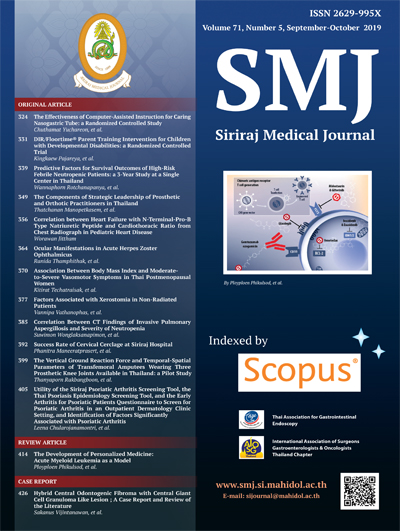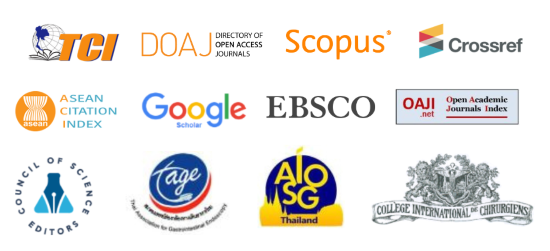Factors Associated with Xerostomia in Non-Radiated Patients
DOI:
https://doi.org/10.33192/Smj.2019.57Keywords:
Xerostomia; underlying disease; medication; non-radiation patientsAbstract
Objective: To identify factors significantly associated with xerostomia in non-radiated patients.
Methods: Patients who attended the outpatient otolaryngology clinic at Siriraj Hospital (Bangkok, Thailand) with complaints of dry mouth were invited to join this study. Collected data included age, gender, body mass index, smoking status, alcohol use, underlying disease, and previous medication and/or therapy. Irradiated patients were excluded. Participants were classified into either the diseased or xerostomia group by abnormal oral cavity examination and symptoms, or the no xerostomia group, which was defined as dry mouth symptoms with no presence of abnormal physical findings.
Results: Two hundred and two participants with a history of dry mouth were consecutively enrolled. There were 86 patients with physical findings compatible with xerostomia, and 116 symptomatic patients without xerostomia. Multivariate analysis revealed age over 50 years (adjusted odds ratio [aOR]: 3.1, 95% confidence interval [CI]: 1.3-7.9; p=0.012), analgesic and muscle relaxant intake (aOR: 3.6, 95% CI: 1.3-9.7; p=0.012), psychotherapeutic medication (aOR: 7.8, 95% CI: 2.6-23.7; p<0.001), and radioactive iodine therapy (aOR: 3.7, 95% CI: 1.2-11.8; p=0.015) to be independent predictors of xerostomia.
Conclusion: Xerostomia is a condition that can adversely affect quality of life. The results of this study revealed older age (≥50 years), analgesics and muscle relaxants, psychotherapeutic medications, and radioactive iodine therapy to be significantly associated with xerostomia. A thorough understanding of the symptoms, diagnosis, relevant risk factors, and effective management is essential for improving outcomes among patients with xerostomia.
Downloads
Published
How to Cite
Issue
Section
License
Users are free to share, copy, and redistribute all articles published in the Siriraj Medical Journal (SMJ) in any medium or format as long as you follow the following terms:
- Attribution — You must give appropriate credit, provide a link to the material, and indicate if changes were made. You may do so in any reasonable manner, but not in any way that suggests the publisher endorses you or your use.
- NonCommercial — You may not use the material for commercial purposes.
- NoDerivatives — If you remix, transform, or build upon the material, you may not distribute the modified material.
- No additional restrictions — You may not apply legal terms or technological measures that legally restrict others from doing anything the license permits.











